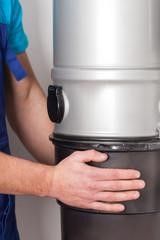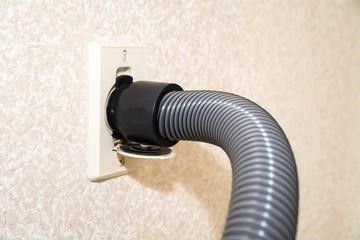How Central Vacuum Systems Work
Table of Contents
How Central Vacuum Systems Work
The central vacuum system is made up of individual components, with each component playing an essential role in lowering the owner's workload. The owner doesn't have to carry around a bulky appliance because the motor is stationary. Since the dust and debris are removed from the living area and emitted outside, there's no unpleasant smell or re-circulated dust. The lightweight hose makes it easy to plug into an inlet and begin cleaning. The individual components of a central vacuum system are discussed below:
The Core: Vacuum Unit
Purpose

At the center of the system is the central vacuum power unit. A powerful motor offers strong suction and deep cleaning, while the filter separates debris.
How it Works
The vacuum unit is situated in a remote location like the garage or basement. The vacuum motor pulls air through the pipes and hose, and all the dust, debris, paper, hair, coins, and even small toys accidentally vacuumed are accumulated and retained in the filter. The exhausted air then is quite clean and is either vented outside or within the part. Depending on the kind and capability of the filter used, it should be replaced every three months to a year. The vacuum is powered on when a vacuum hose is inserted into an inlet within the household.
Options
- Filtration. Disposable or lasting filters.
- Power. 110 or 240 volts. Units are available for every size household.
- Quality. Metal or plastic, name-brand components, or not.
- Sound. Ranges from loud to conversational noise level.
The Control: Vacuum Hose
Purpose

Central vacuum hoses are lightweight, elastic, and crushproof. They come in various lengths and are the only part of the system taken in hand throughout the home and can be used to clean any surface of the household.
How it Works
Traditional Vacuum Hoses: The long hose has two split ends. The wall end gets plugged into one of the vacuum inlet ports throughout the household. Some hoses are designed to make the suction start instantly when plugged in. Other types of hoses are fitted with an on/off switch for the suction on the handle end of the hose. Hide-A-Hose: This hose is confined in the system's pipes until it is pulled out for use. When complete vacuuming, the hose is retracted back into the pipes by the suction of the vacuum.
Options
- Traditional and Hide-A-Hose are available in numerous lengths.
- Traditional hose systems can use a variety of hose kinds.
- Electric hose (conventional type) powers electric vacuum head.
- Hide-A-Hose exists with and without on/off handling switch.
The Connectivity: Pipe and Inlets
Purpose
Vacuum Pipe connects the critical unit to the wall Inlet Valves. The inlet valves, or ports, connect to the hose and make the suction to be turned on and off.
How it Works
The two-inch diameter PVC pipe starts at the central unit and splits off into various areas of the house. It goes into a wall and joins to the back of an inlet. One inlet can cover a large area, sometimes over 1,000 square feet. A Hide-A-Hose inlet that has a 50-foot hose can cover 2,300 square feet. Traditional inlets are available with 110 volts for powerful mat cleaners; Hide-A-Hose does not have that option. All inlets have a low voltage wire linked that turns the suction unit on-and-off.
Options
- Traditional inlets come in a variety of colors and types.
- Traditional inlets present with a 110-volt connection.
- Hide-A-Hose inlets come in three colors.
- Hide-A-Hose inlets are generally mounted higher.




Log In
Create New Account